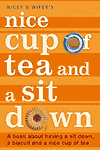Iced Gems | | Wednesday 17 Dec 2003 |
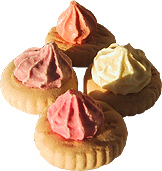 | It's 1850 and in the town of Reading, Berkshire, emerging biscuit giant Huntley and Palmer is experimenting with some new biscuit technology. However, the new biscuits emerge from the oven having actually shrunken. Thomas Huntley likes the resulting mini biscuits which are christened Gems and they sell well. Sixty years later in 1910 they add icing and children's birthday parties would incomplete without these mini biscuits from here on in.
In the 1970s Huntley and Palmer, Peek Frean and Jacobs joined to form Associated Biscuits. American biscuit giant Nabisco took over Associated Biscuits in 1982, and the company was renamed as the Jacobs Bakery Ltd in 1989 and acquired by Danone. Now made in Liverpool there are very few biscuits that can trace their origins back 150 years, and which everybody can remember from their childhood even if you have just had your telegram from the Queen.
Now I have to say that it was with a certain amount of trepidation that I approached the review pack which consisted of six mini bags of Iced Gems. I've always pictured them as a sort of sweetened gravel. When visiting our local builders merchants I find myself subconsciously looking for hundred weight bags of them amongst pea shingle and quarter inch chippings.
Other manufacturers have adopted the mini bag format but Iced Gems have been available like this for donkey's years. There seems to have been a some changes to the Iced Gem since I last had them, er, probably about thirty years ago. The changes however seem to be mainly confined to the icing which is no bad thing. Now some you may have to help me with this but I'm sure there used to be a pale green Iced Gem. Today's iced gems have five colours, white, yellow, orange, red and purple. Chocolate versions are also now available but we thought we'ed stick with the classics. I also don't recall the icing actually tasting of anything that tasted of anything apart from sugar. I also seem to remember there being some fairly lethal sharp points on the icing which could inflict minor havoc on the roof of one's mouth.
So I don't know if I'm happy or sad to see that the points have largely gone and that the icing actually has discernible flavours, slightly fruity ones at that. In fact I really was put in mind of various berries, red currents and blackberries. A ten point piping nozzle places the icing some where on the base and vertical orientation of the biscuit is pot luck. Just in case I was getting carried away, the biscuit base is still as dry and uninspiring as ever. Back in the late 1850's things must have been pretty rough if just straight non-Iced Gems were a big hit. If we hopped in our time machine and went back to the mid eighteen hundreds armed with a pack of Chocolate Hobnobs or even just a simple fruit shortcake no doubt we could actually produce sensory overload and stupefaction in the populace.
The base has on the top side a small square design in the center of which is a solitary hole or 'docker' and measures 21mm by 6mm with the icing taking the whole thing to 20mm high. The underside has a series of parallel marks from the baking surface, presumably some form of wire mesh. Fairly unique among biscuits the edge has a pattern too, vertical scoring some what like a pound coin.
So yes I mildly enjoyed these little old biscuits, but I did find myself strangely missing the puncture wounds in the top of my mouth. Needless to say the younger members of staff devoured them with relish. Your feedback 11 messages |
| Arnott's Gaiety | | Tuesday 9 Dec 2003 |
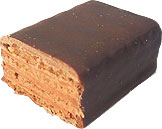 | Today the England Rugby team paraded the Rugby world cup trophy through the streets of London and were bestowed with the freedom of the city. Jubilant fans waved large stuffed Kangaroos which had the St Georges cross spray painted on them. At NiceCupOfTeaAndASitDown we are certainly not going to gloat over this especially as the Wife is in charge of Rugby supporting and is, as many of you know, Irish. So as a gesture of goodwill we have dipped into our Simon Smith box of Aussie goodies to pull out this weeks biscuit, Arnott's Gaiety.
Now there are signs that the great Tescos Arnott's Tim Tam experiment is on the wane, with the antipodean chocolate biscuit bar disappearing from our local Tescos store. When Ross Arnott was looking around for a name for the biscuit he had just invented based on the British Penguin bar he took the name of the 1958 Kentucky Derby winner 'Tim Tam'. Presumably at some point there must have been another horse, or possibly a pony named 'Gaiety'. Naming products after race horses could be a very good plan actually, as in general they have fairly daft names, and it would give everybody a good laugh. It would be nice to clean the oven with a big can of 'Shergar', or maybe spreading a good thick layer of 'Red rum' on your toast. Arnotts obviously think they have a blinder of a name as the have made it a trademark. So what ever it was you wanted to call Gaiety forget it, you've been beaten to it, try and rebuild your shattered dreams and move on.
The waft of chocolate emanating from the pack definitely has the unmistakable scent of Tim Tam about it, and the sheen and finish is also like that of the Tim Tam. So I'll hazard a guess that the two biscuits share more in common than just their manufacturer. In fact the pack goes on to say "At Arnott's we make our own real milk chocolate. We source the finest cocoa ingredients from around the world, and blend them with milk products from Australian pastures. That's why your Arnott's Gaiety tastes so much better!". Of course the neglect to tell us, what it is it is that tastes better than. That's a pity as of course we would have been keen as ever to compare them.
What isn't immediately obvious is that the wafers have been sandwiched together using Hazelnut praline and honey, as neither of these flavours is particularly obvious at all. At a mere 52x28x15mm the Gaiety isn't exactly large, but at least Arnotts have put 12 in a pack unlike the odd numbers we associate with the Tim Tam. So yet again Arnotts have produced a sweet and carefully put together little biscuit. I'm not sure how it would fare against some of the great chocolate covered wafers of the northern hemisphere, such as the Tunnocks or Blue Riband who have a distinct size advantage. The fancy filling seems a little bit lost, but presumably its necessary to get the taste Arnotts were after.
Just in case you thought I had made the name up here is a parting pack shot.
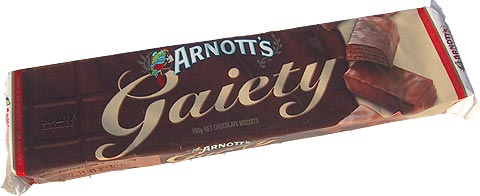
|
| Bahlsen Orange Choco Leibniz | | Sunday 30 Nov 2003 |
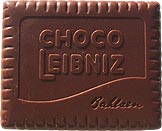
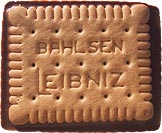 | When all else around you is letting you down there is one fruit above all others that you can rely on. The Orange. Oranges have a special role in the universe by providing one of the key reference points in our perception of reality, and the bonus is that they grow on trees. Not only do Oranges taste of orange, but they smell of orange too. Putting Clementines and Kumquats to one side for a moment, then we find in general they are about the size of an orange too. But their master stroke was to get a whole colour named after them. Not some dodgy made up Homebase paint chart colour like 'Watermelon', no a proper colour that appears in the rainbow. This is the point at which Lemons throw in the towel, along with Limes and Pink Grapefruit who were only along to see what all the fuss was about. To make sure that Orange continues in its unassailable position it has ensured that no new words have entered the English dictionary that might properly rhyme with it. That's why there is no such thing as a 'boringe' or a 'morange'. And now another feather in the cap for Orange as it has recently been selected by German biscuit bakers, Bahlsen, to appear in their much admired Choco Leibniz.
Now the Orange has always had a deep affinity with chocolate, and often goes head to head with Mint when manufactures are looking for a more refined taste for their confectionary or biscuits. We are very lucky that Bahlsen has chosen the UK as the place to launch their Orange Choco Leibniz, so we'll be munching on them before even the Germans who make them. Orange has taken to the Choco Leibniz like a duck to water.
One of the first guest reviews we ever received was Alan Bromley's Choco Leibniz review. Alan did such a good job that we thought it would be churlish to review the biscuits ourselves. However, Bahlsen have now given us the excuse we needed. The Choco Leibniz is really a cult biscuit that enjoys a fiercely loyal following. This ensures that there is always a place for Choco Leibniz in your supermarket. The substrate biscuit is essentially a German version of the French Petite Buerre, and is simply called the Leibniz. They have been baking them since 1891 in Hanover, when Bahlsen had a mere 10 employes. The Leibniz is actually quite a pleasant little biscuit, with the butter flavour clearly present.
The Choco Leibniz prides itself on its unique construction, which involves filling moulds with chocolate then just as it is starting to set dropping in the Leibniz biscuit. The result is a biscuit that has a frill of chocolate and very fine detail in its chocolate relief. Obviously the first thing to do when eating one is to remove the frill of chocolate with your incisors. Having done so you can hold the biscuit securely without getting chocolately fingers.
Bahlsen tell us that people are most loyal to the plain chocolate version, however when the product is in any sort of promotion then the milk chocolate one takes the lions share of sales. Therefore to launch the Orange version it was decided to go for milk chocolate. However, its a fair bet that all you plain chocolate fans will be catered for in due course.
The taste of the new Orange version is at once familiar to any fans of Dawn French's allegedly favourite confectionary. Bahlsen reckon that if you put the two head to head theirs tastes better, and it might well do given the famous quality of their chocolate. The crisp biscuit with the rich orangey chocolate did remind me briefly of vintage orange clubs, so that is praise indeed. Your feedback 7 messages |
| |
|
|
